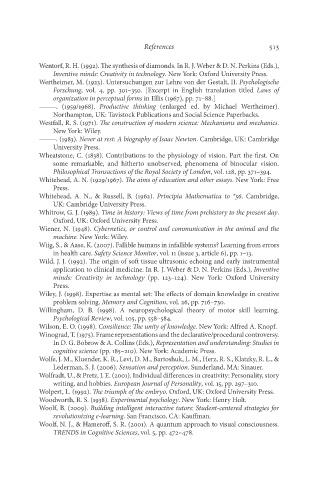Page 530 - Deep Learning
P. 530
References 513
Wentorf, R. H. (1992). The synthesis of diamonds. In R. J. Weber & D. N. Perkins (Eds.),
Inventive minds: Creativity in technology. New York: Oxford University Press.
Wertheimer, M. (1923). Untersuchungen zur Lehre von der Gestalt, II. Psychologische
Forschung, vol. 4, pp. 301–350. [Excerpt in English translation titled Laws of
organization in perceptual forms in Ellis (1967), pp. 71–88.]
———. (1959/1968). Productive thinking (enlarged ed. by Michael Wertheimer).
Northampton, UK: Tavistock Publications and Social Science Paperbacks.
Westfall, R. S. (1971). The construction of modern science: Mechanisms and mechanics.
New York: Wiley.
———. (1983). Never at rest: A biography of Isaac Newton. Cambridge, UK: Cambridge
University Press.
Wheatstone, C. (1838). Contributions to the physiology of vision. Part the first. On
some remarkable, and hitherto unobserved, phenomena of binocular vision.
Philosophical Transactions of the Royal Society of London, vol. 128, pp. 371–394.
Whitehead, A. N. (1929/1967). The aims of education and other essays. New York: Free
Press.
Whitehead, A. N., & Russell, B. (1962). Principia Mathematica to *56. Cambridge,
UK: Cambridge University Press.
Whitrow, G. J. (1989). Time in history: Views of time from prehistory to the present day.
Oxford, UK: Oxford University Press.
Wiener, N. (1948). Cybernetics, or control and communication in the animal and the
machine. New York: Wiley.
Wiig, S., & Aase, K. (2007). Fallible humans in infallible systems? Learning from errors
in health care. Safety Science Monitor, vol. 11 (issue 3, article 6), pp. 1–13.
Wild, J. J. (1992). The origin of soft tissue ultrasonic echoing and early instrumental
application to clinical medicine. In R. J. Weber & D. N. Perkins (Eds.), Inventive
minds: Creativity in technology (pp. 123–124). New York: Oxford University
Press.
Wiley, J. (1998). Expertise as mental set: The effects of domain knowledge in creative
problem solving. Memory and Cognition, vol. 26, pp. 716–730.
Willingham, D. B. (1998). A neuropsychological theory of motor skill learning.
Psychological Review, vol. 105, pp. 558–584.
Wilson, E. O. (1998). Consilience: The unity of knowledge. New York: Alfred A. Knopf.
Winograd, T. (1975). Frame representations and the declarative/procedural controversy.
In D. G. Bobrow & A. Collins (Eds.), Representation and understanding: Studies in
cognitive science (pp. 185–210). New York: Academic Press.
Wolfe, J. M., Kluender, K. R., Levi, D. M., Bartoshuk, L. M., Herz, R. S., Klatzky, R. L., &
Lederman, S. J. (2006). Sensation and perception. Sunderland, MA: Sinauer.
Wolfradt, U., & Pretz, J. E. (2001). Individual differences in creativity: Personality, story
writing, and hobbies. European Journal of Personality, vol. 15, pp. 297–310.
Wolpert, L. (1992). The triumph of the embryo. Oxford, UK: Oxford University Press.
Woodworth, R. S. (1938). Experimental psychology. New York: Henry Holt.
Woolf, B. (2009). Building intelligent interactive tutors: Student-centered strategies for
revolutionizing e-learning. San Francisco, CA: Kauffman.
Woolf, N. J., & Hameroff, S. R. (2001). A quantum approach to visual consciousness.
TRENDS in Cognitive Sciences, vol. 5, pp. 472–478.

